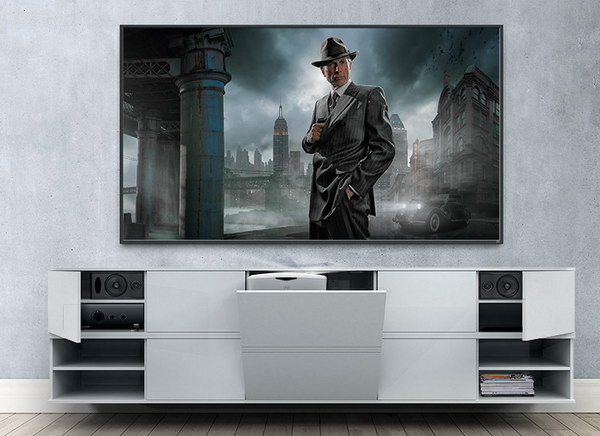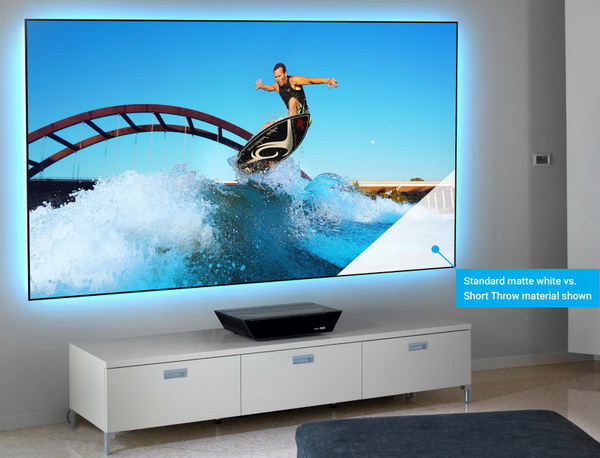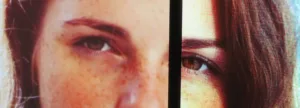I visited the Stewart Filmscreen, DNP and Screen Innovations booths at ISE to see what was new in the projection screen business. The answer was, not much this year.
Stewart was highlighting its new FideLEDy system. This is a transparent screen that overlays a direct-view LED system in order to reduce the visibility of the individual LED pixels and shown last year. This is primarily targeted at LED screens that are used on-set in TV studios. In particular, it is designed to reduce or eliminate moiré effects caused by the interaction of the pixel structure of the LED display and the pixel structure of the camera. The ISE demonstration showed a Fideledy screen being used with a SiliconCore 2.6mm pitch display. In the image, the left half is covered by the Fideledy screen and the right half is uncovered. As can be seen, the Fideledy screen did significantly reduce artifacts in the image, at least with my camera.
According to the Stewart rep, an alternative approach is to use a very fine pitch LED screen to eliminate moiré, but this is a very expensive solution. While a normal size 2.6mm LED display for on-set use might cost $50,000, plus $3,000 for the Fideledy screen, a 1.0mm pitch LED display would typically cost about $65,000 per square meter.
The Stewart FidLEDy system is intended to reduce artifacts in an image of a LED screen used on-set.
While Steward was also showing their conventional projection screens at ISE, they did not introduce any significant new products.
When I visited the DNP booth, they also did not have any significant new screen innovations either. They said they were disappointed in the sales of their 100” prismatic light rejecting screens for short-throw projectors. Part of this they attributed to the lack of end-user knowledge of light rejecting screens for short throw projectors. So, at ISE 2016, they had introduced the LaserPanel system, which is a bundled short-throw laser/phosphor projector and a 100” light rejecting screen. This comes in two versions, LaserPanel and LaserPanel Touch. The systems are identical except the Touch version incorporates the sensors needed for optical touch detection in the projector. The DNP rep said the laser panel system cost in the $7,000 – $8000 range. The only new products actually introduced at ISE 2017 by DNP were office furniture designed around the LaserPanel system.
 LaserPanel system from DNP, showing some of the available furniture. (Source: DNP Denmark)
LaserPanel system from DNP, showing some of the available furniture. (Source: DNP Denmark)
Screen Innovations showed their similar package that included their short throw Zero Edge screen and a SIM2 XTV short throw projector. This projector is a FHD (1920 x 1080) single chip DLP projector with a laser-phosphor light source and a lens throw ratio of 0.25:1. While the screen is contrast-enhancing, the image quality was underwhelming on the brightly lit ISE show floor.
 Screen Innovations Zero Edge screen with a SIM2 short-throw projector (Source: Screen Innovations)
Screen Innovations Zero Edge screen with a SIM2 short-throw projector (Source: Screen Innovations)
Other innovations at SI were modest. They can now manufacture their Slate contrast enhancing screen in sizes up to 200” without seams and the Slate material is now available perforated for speakers behind the screen. In addition, they were showing their Zero G screen mounting and retracting system that could make a screen vanish completely into a ceiling. This system is targeted at the residential TV market, where finding a place for a large projection screen can be difficult or impossible. This system can use any of the SI flexible screen materials, including Slate 1.2 and 0.8 contrast enhancing screens or their pure white or pure gray materials. – Matthew Brennesholtz

